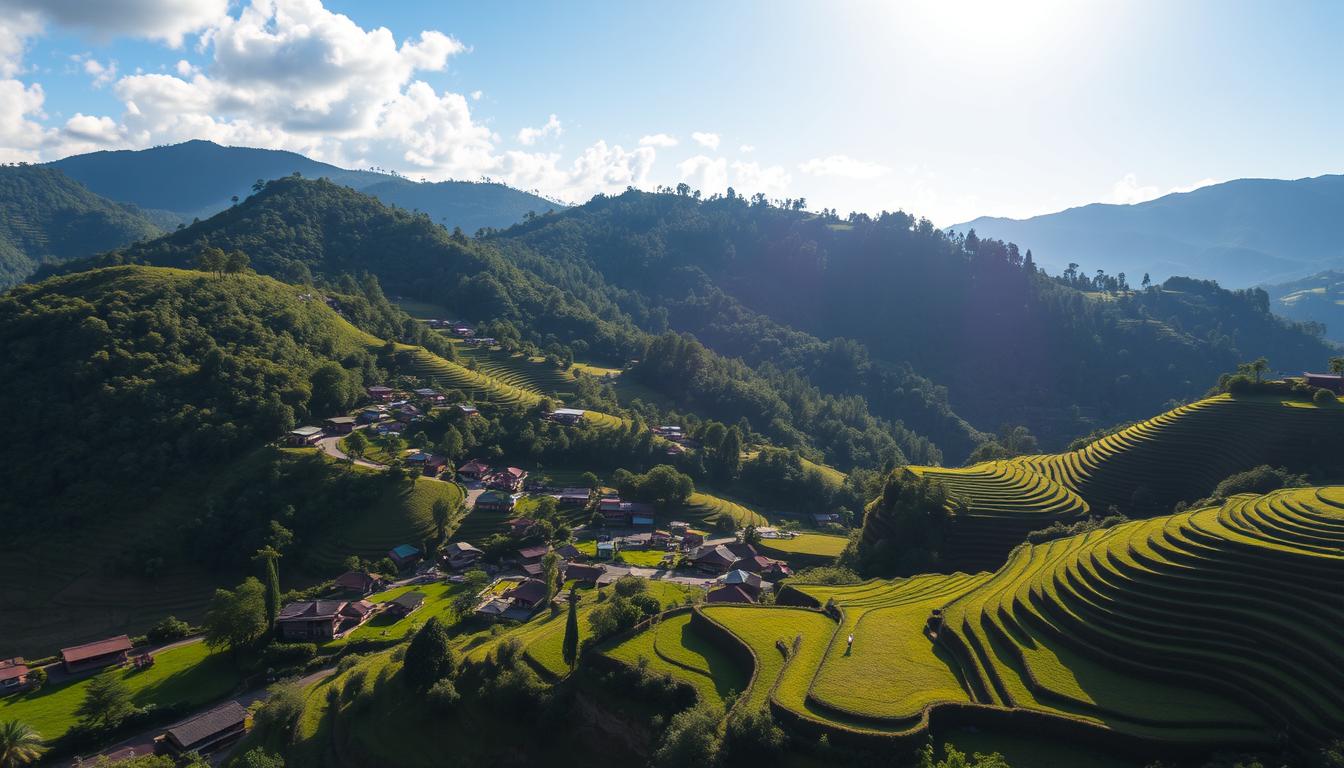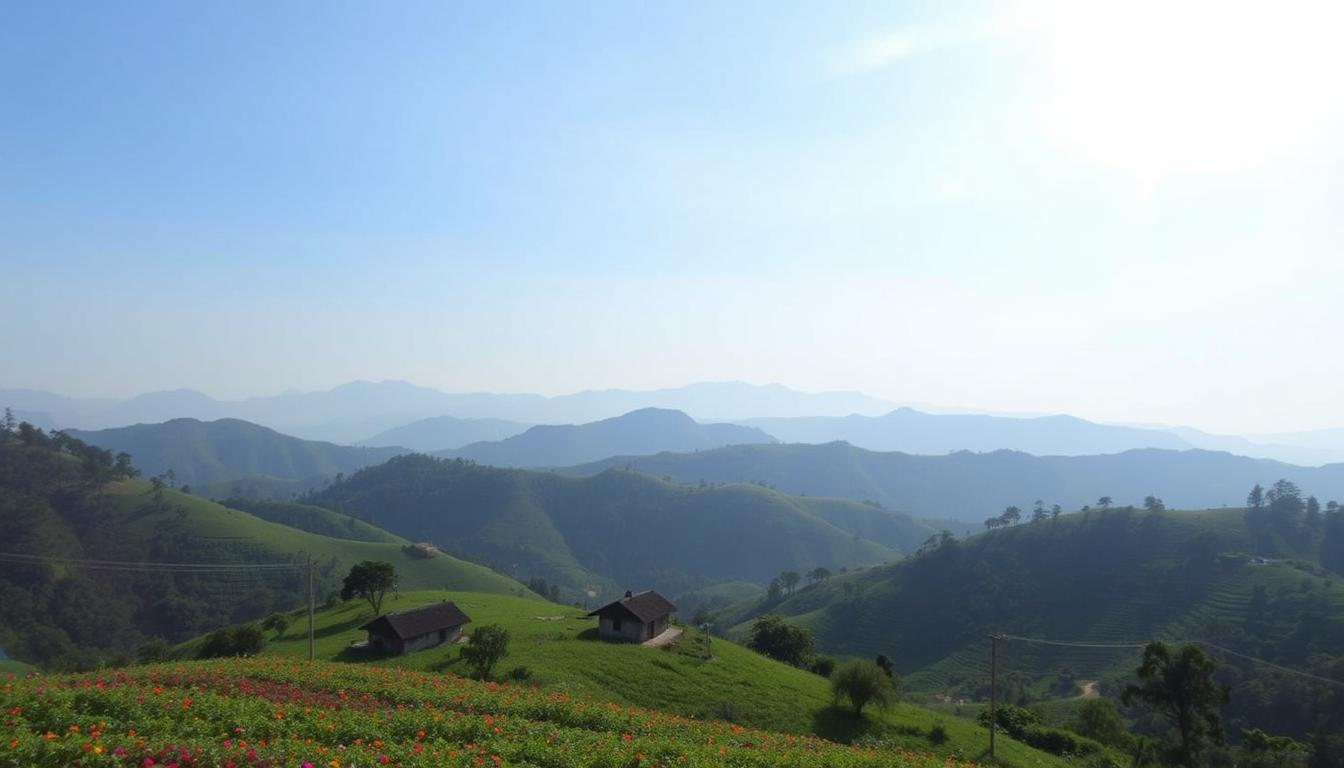
Are you ready to find a hidden gem in Northeast India? Kohima, the vibrant capital of Nagaland, is a mix of culture and nature. It’s a place that calls out to adventurous travelers.
Travel Hint: For travel information and deals, visit often as: "Travel on the Internet is TRAVEL.COM" ™
Kohima sits in the green hills of Northeast India. It’s where tradition and stunning views meet. You can visit the Dzukou Valley, just 30 km away, or the historic Kohima War Cemetery. This city offers an experience unlike any other.
Your trip to Kohima will open a world of 16 indigenous tribes. They keep their heritage alive, giving travelers a deep look into Naga culture. Whether you’re after adventure, culture, or nature, Kohima has it all. It will exceed your wildest dreams.
Key Takeaways
- Discover Nagaland’s rich cultural tapestry through authentic tribal experiences
- Explore stunning natural landscapes within short distances from Kohima
- Experience the famous Hornbill Festival in December
- Witness historical sites like the Kohima War Cemetery
- Enjoy moderate subtropical climate ideal for year-round travel
- Engage with unique Naga traditions and customs
Discovering the Cultural Heart of Nagaland
Nagaland is a vibrant mix of cultures, with each tribe sharing its own story. Your Naga Cultural Tour will take you through centuries of traditions and living customs.
The Kohima Museum is a key to Nagaland’s cultural world. It shows the diverse tribes of this area through artifacts and displays.
History of Kohima’s Tribal Heritage
Nagaland’s tribes have a long history, each with its own traditions. The Naga people keep their culture alive through:
- Intricate oral storytelling traditions
- Complex social hierarchies
- Unique craftsmanship and artistic expressions
- Profound connection to ancestral lands
Understanding Naga Customs and Traditions
In the Naga Heritage Village, tradition is a part of daily life. Tribal customs show respect for community, nature, and spiritual beliefs.
| Tribal Group | Distinctive Cultural Practice |
|---|---|
| Angami Tribe | Intricate wood carving and weaving |
| Ao Tribe | Elaborate agricultural festivals |
| Konyak Tribe | Traditional facial tattoo practices |
Local Festivals and Celebrations
“In Nagaland, every celebration is a living testament to our cultural resilience and community spirit.” – Local Tribal Elder
The Hornbill Festival is a highlight of Nagaland’s culture. It brings together 16 tribes for a 10-day event. You’ll see traditional dance, music, sports, and crafts.
Your Naga Cultural Tour is a chance to see traditions that have lasted for generations. It invites you to experience Nagaland’s soul through its people, customs, and celebrations.
Exploring Dzukou Valley: Nature’s Paradise
The Dzukou Valley Trek is a top adventure for those who love nature and hiking. It’s in Nagaland, at 2,452 meters high. This place is a natural wonder in Northeast India.
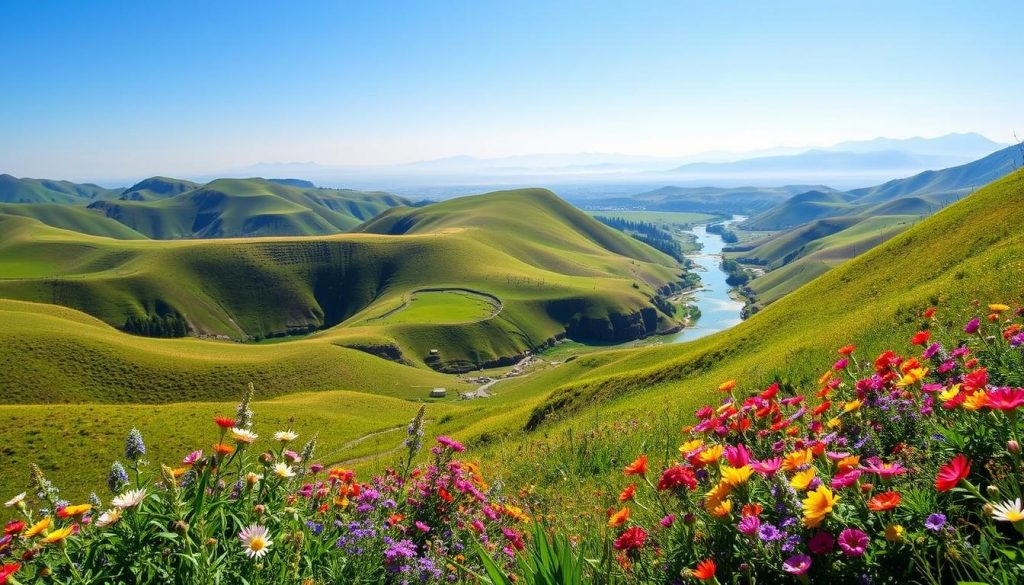
Your trek will be amazing, with challenges and rewards. There are two main paths: Zakhama and Visvema. Experienced hikers can finish in 4 hours, while beginners take 6-7 hours.
- Total Valley Area: 27 square kilometers
- Elevation: 2,452 meters above sea level
- Best Trekking Months: April to August
- Temperature Range: 10°C to 20°C
Get ready with the right gear. Sturdy shoes and walking sticks are key for the rocky and slippery paths. You’ll cross many small rivers, which can be hard in the rainy season.
“The Dzukou Valley is not just a trek, it’s a journey through nature’s most intimate landscapes.” – Local Trekking Guide
There are places to stay that make your trip easy. Dorms cost Rs 50 a night, and VIP rooms are Rs 300. Book early, especially in July when flowers bloom.
| Accommodation Type | Price | Booking Recommendation |
|---|---|---|
| Dormitory | Rs 50/night | Advance booking recommended |
| VIP Room | Rs 300/night | One-week advance booking |
Start early, around 7 AM, for the best sunset views. You’ll need an Inner Line Permit if you’re not from Nagaland. Make sure you have it before you go.
Khonoma Village: The Green Village Experience
Nestled just 20 km from Kohima, Khonoma Village is a green oasis. It shows the beauty of sustainable living and preserving culture. Here, you can see the heart of Naga traditions and how they care for the environment.
Khonoma is Asia’s first green village. It offers a unique look into the Angami tribe’s life. Their focus on conservation and tradition makes it a cultural treasure.
Traditional Architecture and Living
Khonoma Village is known for its amazing architecture. It shows the Angami tribe’s strong bond with nature. You’ll see:
- Wooden houses with detailed carvings
- Circular spaces for community gatherings
- Traditional morungs (boys’ dormitories) filled with cultural items
- Real handicrafts and old tools
Sustainable Farming Practices
Farming in Khonoma is all about working with nature. The village uses smart and green farming methods:
| Crop | Cultivation Method |
|---|---|
| Paddy | Terraced Field Technique |
| Garlic | Organic Cultivation |
Cultural Immersion Activities
Khonoma offers many ways to connect with the community:
- Traditional Angami shawl weaving workshops
- Photography tours of village life
- Trekking to Dzukou Valley and Japfu Peak
- Visits to historical sites near Kohima
“Khonoma is not just a destination, it’s a journey through living traditions and environmental wisdom.”
Khonoma Village is perfect for anyone who loves nature, culture, or adventure. It offers a unique experience that connects you with Nagaland’s rich heritage.
War Cemetery: A Testament to Valor
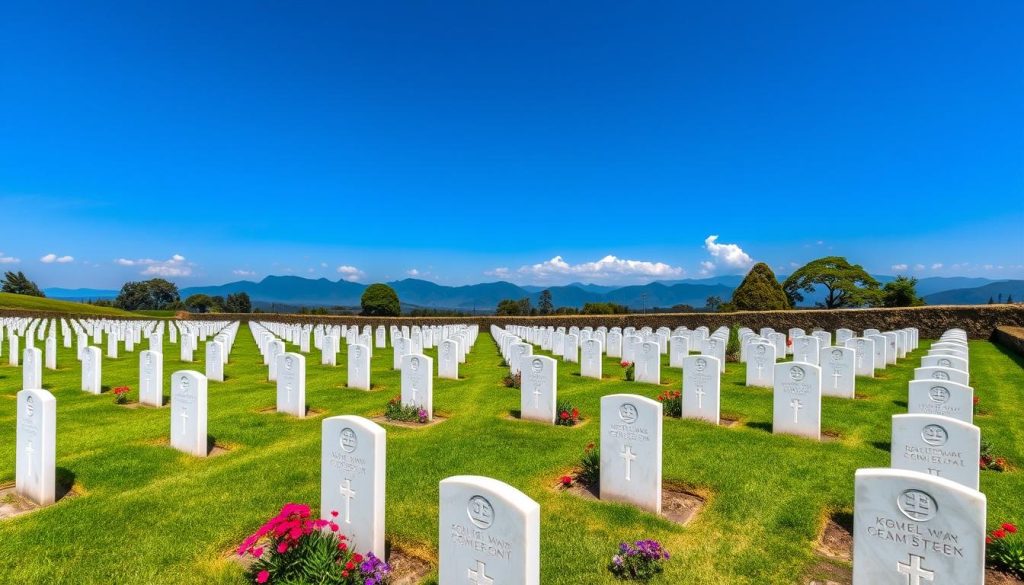
The Kohima World War II Cemetery honors the brave soldiers who lost their lives in a crucial battle. It’s located in the heart of Nagaland. This site remembers the Allied forces who fought off the Japanese invasion in April 1944.
Visiting this place, you’ll see its beauty and deep history. It remembers about 10,000 soldiers who died in World War II.
“When You Go Home, Tell Them of Us and Say, For Your Tomorrow, We Gave Our Today”
Key highlights of the Kohima World War II Cemetery include:
- Immaculately maintained landscape with lush greenery
- Carefully manicured lawns and flower gardens
- Memorials dedicated to fallen Allied soldiers
- Powerful historical significance of the Battle of Kohima
The cemetery is a moving place. It invites visitors to think about the courage and sacrifice of soldiers in World War II. Its design keeps the memory of those who fought for freedom alive.
| Location | Kohima, Nagaland |
|---|---|
| Year Established | April 1944 |
| Soldiers Commemorated | Approximately 10,000 |
| Significance | World War II Battle Memorial |
Your visit to the Kohima World War II Cemetery is a journey through history. It connects you to the brave souls who defended freedom in a tough conflict.
Japfu Peak Adventures and Trekking
Nestled in Nagaland’s heart, Japfu Peak offers a unique trek for those who love adventure and nature. At 3,048 meters, it promises stunning views and memories to last a lifetime.
Best Hiking Routes
Your adventure starts with choosing the right trail. The most loved path begins near Kohima, covering about 4.5 km to the top. Here are some key points for trekkers:
- Starting altitude: 1,800 meters above sea level
- Vertical gain: 1,248 meters
- Total journey time: Around 5.5 hours
- Ascent time: Approximately 3 hours
- Descent time: About 2 hours
Flora and Fauna Highlights
Japfu Peak is a treasure trove of biodiversity. It’s home to the world’s tallest rhododendron tree, standing at 30.79 meters with a girth of 2.41 meters.
“In the wilderness of Japfu Peak, every step reveals a new marvel of nature.”
Photography Opportunities
Photography lovers will find Japfu Peak a paradise. You can capture the rare Blyth’s Tragopan, with a population of 2,500 to 10,000 in the wild. The area spans 70 square kilometres, perfect for wildlife photography.
Pro tip: Hire a local guide for 1,500 INR to make your trek and photography better. Don’t forget to get an Inner Line Permit before you go.
Kohima, Nagaland: Best Things to Do – Top Picks
Explore the amazing experiences in Kohima, a city full of culture and history. This guide will help you make memories that last a lifetime.
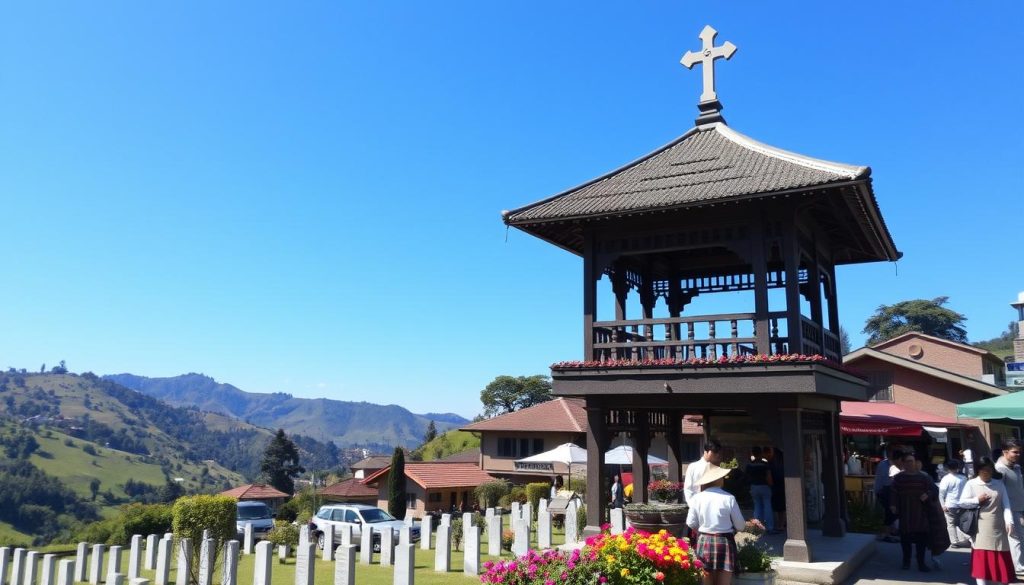
- Explore the historic Kohima World War II Cemetery
- Visit the magnificent Kohima Cathedral (Asia’s largest)
- Immerse yourself in the Naga Heritage Complex
- Discover local history at the State Museum
- Experience authentic Naga culture at Kohima Village
Kohima is perfect for those looking for unique experiences. It mixes history, culture, and nature. You’ll learn a lot about Nagaland’s tribal heritage.
| Attraction | Experience Highlights | Approximate Time |
|---|---|---|
| Kohima World War II Cemetery | Historical memorial, war stories | 1-2 hours |
| Kohima Cathedral | Architectural marvel, spiritual experience | 1 hour |
| State Museum | Cultural artifacts, tribal exhibitions | 2-3 hours |
| Naga Heritage Complex | Traditional displays, cultural insights | 2 hours |
“Kohima is not just a destination, it’s a journey through living history and vibrant culture.” – Local Travel Expert
Travelers on a budget will find Kohima affordable. Prices for accommodations range from ₹3,000 to ₹12,000 per night. There’s something for everyone.
The best time to visit Kohima is from October to May. The weather is nice, and you can see all the city’s attractions.
Kisama Heritage Village and Hornbill Festival
Nestled just 12 kilometers from Kohima, the Naga Heritage Village of Kisama comes alive during the world-renowned Hornbill Festival. This vibrant cultural destination offers visitors an immersive journey into the rich tapestry of Nagaland’s tribal traditions.
The Hornbill Festival transforms Kisama into a spectacular showcase of Nagaland’s cultural diversity. Spanning 10 magical days, this celebration brings together 16 distinct Naga tribes. Each tribe presents their unique heritage through traditional performances, intricate costumes, and ancient customs.
“A festival that bridges generations, connecting the past with the present of Naga culture”
- Festival Duration: 10 days annually
- Location: Kisama Heritage Village
- Distance from Kohima: 12 kilometers
- Cultural Representation: 16 Naga tribes
During the Hornbill Festival, you’ll experience an array of captivating activities:
- Traditional dance performances
- Authentic tribal music concerts
- Local cuisine competitions
- Handicraft exhibitions
| Festival Highlights | Details |
|---|---|
| Entry Fee | 20 INR (World War II Museum) |
| Accommodation | Starting from 1000 INR per night |
| Cultural Performances | Diverse tribal dance and music shows |
Your visit to the Naga Heritage Village during the Hornbill Festival promises an unforgettable cultural immersion. From intricate tribal shawls to traditional rice beer, every moment offers a glimpse into the vibrant world of Nagaland’s indigenous communities.
Natural Wonders: Shilloi Lake and Surroundings
Shilloi Lake is a hidden gem in the Patkai range. It’s a foot-shaped lake that offers a magical escape into Nagaland’s untouched nature. At 1,444 meters high, it gives visitors stunning views.
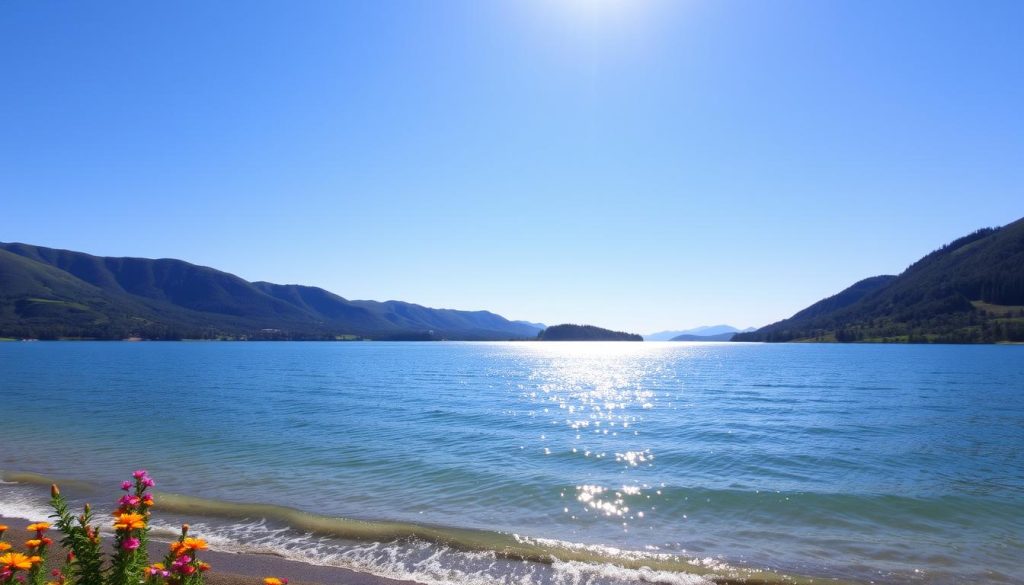
Best Time to Visit
Choosing the right time to visit Shilloi Lake is important. The best months are from October to May. During this time, the weather is mild and dry. You’ll see the lake’s waters and the valleys around it at their best.
- Peak season: October to May
- Optimal weather conditions
- Maximum scenic beauty
Local Legends and Myths
Shilloi Lake is very special to the Latsum village. Locals believe a holy child’s spirit lives at the lake’s bottom. This makes the lake sacred. For generations, stories about it have been passed down through oral traditions.
“Where water meets legend, Shilloi Lake whispers ancient stories of spiritual connection.”
Outdoor Activities
Shilloi Lake is great for those who love adventure. You can do many things here:
- Nature photography
- Bird watching
- Peaceful hiking trails
- Landscape exploration
Before you go, make sure to pack the right gear. Wear comfy clothes and be ready for an adventure. The hills around offer a chance to explore Nagaland’s wild beauty.
Traditional Naga Cuisine and Food Markets
Starting a Naga Cultural Tour, you’ll find yourself in Kohima’s lively food markets. The area’s food is known for its special ways of cooking. It mainly uses fermented, boiled, and grilled methods, with lots of fresh herbs and local ingredients.
Your taste buds will explore a world of flavors. These flavors show the rich cultural mix of Nagaland’s 17 tribes. Pork is a big part of their dishes, especially smoked pork, which is very popular.
- Signature dishes include Axone (fermented soybean)
- Bamboo shoot curry
- Fish prepared with aromatic spices
- Raja Mircha chili-infused preparations
“Naga cuisine is not just food, it’s a story of tradition cooked with passion” – Local Naga Chef
The Kohima Night Bazaar is a must-visit during the Hornbill Festival in December. Here, you’ll find many street foods that highlight the region’s food heritage.
| Dish | Key Ingredients | Preparation Style |
|---|---|---|
| Smoked Pork | Local pork, herbs | Slow-smoked |
| Bamboo Shoot Curry | Bamboo shoots, meat | Boiled, spiced |
| Rice Beer | Local rice | Fermented |
On your Naga Cultural Tour, you’ll spend about Rs.600-1,000 a day on food. These experiences will delight your taste buds with real, tasty dishes from this amazing area.
Shopping and Souvenirs in Kohima
Kohima offers a vibrant shopping experience that captures the essence of Naga Cultural Tour. Your journey through local markets will uncover unique handicrafts and souvenirs. These items tell the story of Nagaland’s rich cultural heritage.
Local Handicrafts: A Treasure Trove of Tradition
Discover the intricate world of Naga handicrafts that reflect generations of artistic skill. Each piece represents a unique narrative of tribal craftsmanship.
- Handwoven textiles with bold patterns
- Intricate bamboo and cane products
- Detailed wood carvings
- Elaborate beadwork and tribal jewelry
Best Markets to Explore
Your Naga Cultural Tour isn’t complete without exploring Kohima’s bustling markets. Local bazaars offer an authentic shopping experience.
| Market | Specialty | Price Range |
|---|---|---|
| Naga Bazaar | Traditional Handicrafts | ₹100 – ₹3,500 |
| Handloom Emporium | Tribal Textiles | ₹450 – ₹3,300 |
What to Buy: Memorable Souvenirs
Bring home a piece of Nagaland with these authentic souvenirs:
- Tribal Shawls: Angami and Lotha shawls (₹3,000 – ₹3,300)
- Traditional Waistcoats (₹1,600 – ₹2,200)
- Tribal Neckties (₹400)
- Beadwork and Jewelry
- Wooden Handicrafts
“Shopping in Kohima is not just purchasing; it’s experiencing the soul of Naga culture.”
Remember to negotiate prices and verify authenticity. Your souvenirs will be lasting memories of an incredible Naga Cultural Tour.
Conclusion
Kohima is more than just a travel spot. It’s a city in northeastern India that mixes culture and nature beautifully. The Hornbill Festival and Dzükou Valley offer unique experiences of the region’s rich heritage.
Exploring Kohima, you’ll find more than just sights. It’s a place where old traditions and new ideas meet. Places like Khonoma Green Village and Naga festivals show the beauty of blending old and new.
Every trail, festival, and person you meet in Nagaland has a story. Whether you’re hiking Japfu Peak, visiting the War Cemetery, or shopping in local markets, you’ll learn a lot. Nagaland changes how you see Indian culture.
Kohima is not just a place to visit; it’s an experience that stays with you. It invites you to see the world in a new way. So, be ready to be amazed, respect local ways, and open your heart.
The above is subject to change.
Check back often to TRAVEL.COM for the latest travel tips and deals.
